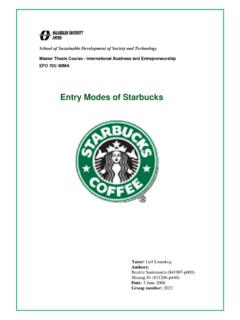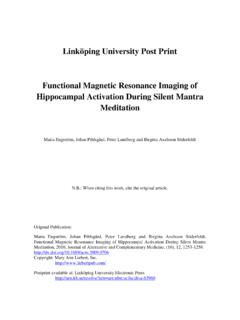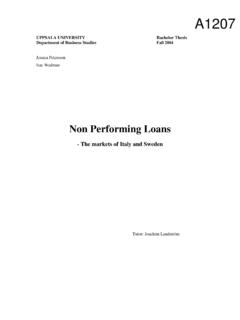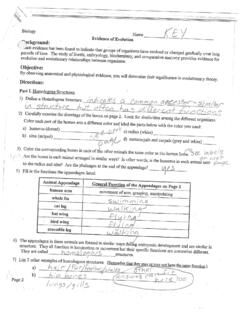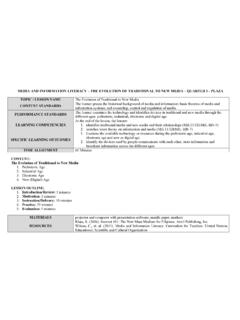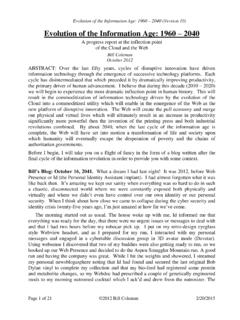Transcription of The Evolution of Quality Management - DiVA portal
1 Quality Management for Tomorrow Bjarne Bergquist Lule University of Technology, Sweden E-mail: Rickard Garvare Lule University of Technology, Sweden E-mail: Bengt Klefsj Lule University of Technology, Sweden E-mail: The Evolution of Quality Management The Quality movement has a long and complex history, and not surprisingly its Evolution from the industrial revolution to present day has been interpreted in several different ways. One version emphasizes four relatively distinct phases; another identifies two different movements evolving more or less in parallel, while a third emphasizes a more continuous development. Four phase model Perhaps the most common description of way in which Quality and Quality improvements have evolved into the present day Total Quality Management (TQM) is that which identifies the four phases or stages illustrated in Figure 1: Quality Inspection, Quality Control, Quality Assurance, and TQM [Garvin, 1988; Kanji & Ascher, 1993; Dale, 1999 and Dahlgaard et al.]
2 , 1998]. Total Quality Management Quality Assurance Quality ControlQuality Inspection Figure 1 Illustration of the concepts of Quality inspection, Quality control, Quality assurance and total Quality Management . The figure shows one common description of the Evolution of Quality Management . [From Bergman & Klefsj 2003]. 1 The Quality inspection stage started about 1910 when the Ford Motor Company, then one of the world s largest manufacturers, employed teams of inspectors to check the Quality of the T-model car1. The idea behind Quality inspection was that poor Quality products could be found by inspection and then either scrapped, reworked or sold as lower Quality products. By the 1920s and 1930s, Statistical Quality Control (which was developed, mainly by Walter A. Shewhart), was being adopted by Ford and many other manufacturing companies in order to identify problems earlier and control the manufacturing process, instead of rejecting or repairing afterwards.
3 However, despite the work of Shewhart [1931, 1939] on variation and its causes playing a fundamental role in the Evolution of Quality Management to this day Quality inspection continues to be used in many companies [Bergman & Klefsj , 2003]. The Quality Assurance stage focuses on pre-production activities and relies on Quality stand-ards [most notably, ISO 9000] or instructions to assist with the reduction of the risk of failures and mistakes in the processes used to produce a product or service. ISO 9000, which was first published by the International Organization for Standardization (ISO) in 1987, is now used extensively throughout the world. Today, more than 670 000 organizations world wide are third party certified to ISO 9001 The fourth and current stage, TQM, involves understanding and implementing Quality man-agement principles and concepts in every aspect of an organization, including its customers and suppliers.
4 This development, which has a clear systems approach, has been described by Bergman & Klefsj [2003, p. 34] as a constant endeavour to fulfil, or preferably exceed customer needs and expectations at the lowest cost, by continuous improvements work, to which all involved are committed, focusing on the processes in the organization . Although for the most part the four stages have largely replaced each other during the evolu-tion, to some extent the stages have overlapped and have continued in parallel. Kroslid s two schools Kroslid [1999] uses the Deterministic and Continuous Improvement schools of thought to de-scribe the Evolution of Quality Management . The Deterministic School is described by Kroslid 1 See Ford [1926] for a description of his Quality and Management ideas. 2 From in the survey from December 2004. 2 [Kroslid, 1999, ] as evolving.
5 Around a deterministic view of reality with a belief in the existence of one best way . That is, conformance to standards is the best way to meet customer requirements. On the other hand the Continuous Improvement School is described as being .. founded on a reality full of variation, with an awareness of improvement potential in every aspect of work [Kroslid, 1999, ]. Continuous improvements reduce the impact of environmental changes and other variations. The Deterministic School, which has its origin in the work of Frederick Winslow Taylor [1911], has been further developed by Philip Crosby and ISO 9000, while the Continuous Improvement School has Walter A. Shewhart, Armand V. Feigenbaum and W. Edwards Deming among its leading proponents. However, according to Bergman & Klefsj [2003], the two schools are now converging. Park Dahlgaard s Continuous Process Park Dahlgaard [1999, p.]
6 474] by contrast states that the four stage model mentioned above is too narrow an approach .. and is primarily focused on the technical aspects of the Quality movement. When focusing on other aspects such as general Management viewpoints, learning aspects, sociological viewpoints and human relation aspects, the classification is no longer appropriate. The Evolution of TQM, as described by Park Dahlgaard et al. [2001], can be seen as a continuous process, consisting of a fusion of Eastern and Western ideas, that has gradually shaped TQM. According to this approach the result is a theory, wherein the rational and logical elements stemming from western theorists are synthesized with the holistic, dynamic and humanistic parts emerging from Japanese practices. The origins of the term TQM There is some discussion over the origin of the name TQM; see, for instance, Bergman & Klefsj [2003].
7 Some argue that the term TQM was coined in 1984 when the NALC [Naval Aviation Logistics Command] was about to implement Quality improvement according to the ideas presented in Ishikawa s book Total Quality Control , but did not like the word control . One of the employees, Nancy Warren, is said to have suggested Management instead. Deming is talking about Management 3. Others suggest that the origin of the name is actually a mistranslation from Japanese [Xu, 1994]. In Japanese there is no difference in 3 From personal communication with William Latzko in 1998. Similar thoughts are presented in Bounds et al. [1994]. 3 meaning between the terms for control and Management . Yet another school of thought represented by Park Dahlgaard et al.
8 [2001] contend that the concept may have been created by Armand Feigenbaum, but point out that there is no actual proof. However, the late American teacher and consultant William Golomski has told one of the authors that Koji Kobayashi, former executive at NEC (Nippon Electric Company), was the first one to use the term TQM in his speech when receiving the Deming Prize as far back as 1974. The gurus and TQM The origins of what is today known as Total Quality Management may be traced back to the early 1950s and derives from the concepts established by writers such as W. Edwards Deming, Joseph M. Juran and Kaoru Ishikawa. Inspired by their ideas, Japanese top managers and their companies extended and customized the integrated approach and culture4 of TQM. Japan s enormous post-war achievements in the Quality field put pressure on the Western business world to put Quality back on the agenda. Juran and Deming were without doubt key figures in the Japanese development, but it is also worth mentioning the influence of Homer M.
9 Sarasohn. As Chief of the Industrial Branch of the Civil Communication Section of the Supreme Command Allied Powers, he was asked by General McArthur to help reconstruct the Japanese communication industry. The work of Sarasohn, together with Charles A. Protzman and others, predated the work done in Japan by Deming and Juran by several years. Indeed it was Sarasohn who made the call to Deming in 1950 when Shewhart was unable to accept an invitation to Japan from JUSE due to illness. In June 1949 Sarasohn and Protzman began a series of seminars on The Fundamentals of Industrial Management in Tokyo [Foley, 2004, ]. It might be of interest here to note that the so-called gurus of TQM have almost never actually used the term. Deming went so far as to say when asked about TQM .. there is no such thing. It is just a buzzword. I have never used the term, as it carries no meaning [Deming, 1994]. 4 The concept of culture is complex and can be looked upon from many angles.
10 As a result, there are many definitions available within the literature. Schein [1996, ] defines culture as a pattern of basic assumptions invented, discovered, or developed by a given group as it learns to cope with its problems of external adaptation and internal integration that has worked well enough to be considered valid and, therefore, to be taught to new members as the correct way to perceive, think, and feel in relation to those problems. 4 Interpretation of the TQM concept Every new year seems to bring new definitions and descriptions of TQM ; see Oakland [1993], Dahlgaard et al. [1998] and Dale [1999]. Dale on one hand defined TQM, in accordance with ISO 8402, as a Management approach of an organization, centred on Quality , based on the participation of all its members and aiming at long-term success through customer satisfaction, and benefits to all members of the organization and to society 5.

